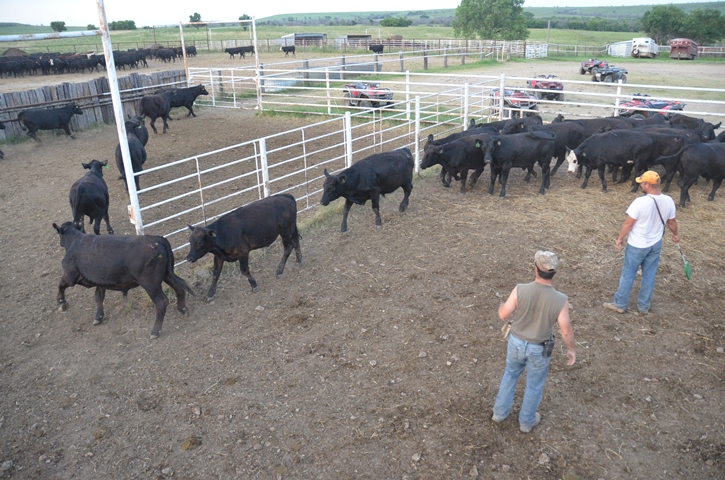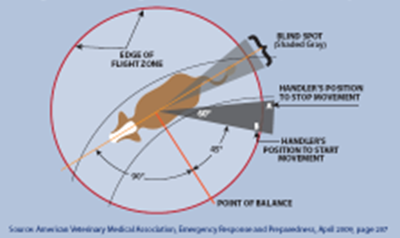
Cattle Appearance
There are many different breeds and types of cattle. Some breeds of Bos indicus descent have humps on their necks and naturally droopy ears. These breeds also have less hair than many of the Bos taurus breeds of cattle. Bos indicus cattle usually handle high temperatures much better than the Bos taurus breeds. However, Bos taurus is more comfortable in colder weather climates. Within the two species, there can also be large variations in body frame, size, and shape.

Cattle Behaviour
Cattle behaviour is best understood and explained in the context of cattle as a prey species. Their senses are developed to rapidly detect changes in their environment. Cattle seem to have the poor detailed vision but are very good at detecting changes in light and movement. They also have excellent hearing. In most situations, prey animals will flee situations they find alarming. Cattle will tend to escape if an alarming presence is detected within their flight zone – an area in which a threat is determined to be too close for comfort. Flight zone size depends on each animal’s temperament and previous experiences. Some flight zones are small enough to allow close contact with the animal and some are extremely large. It is also important to realize that as prey animals, cattle may hide signs of disease or pain until it becomes overwhelming. In the wild, diseased or injured animals are targeted by predators and prey species have adapted to hide these signs. This behaviour can complicate early disease detection in animals, especially if they are easily excited. Cattle will usually cluster together in groups even on very warm days if they are being bothered by flies and other insects. Good pest management can help to alleviate this and also help to prevent cattle from becoming too warm while clustered together on hot days.
Methods for Safe Restraint of Beef Cattle
Squeeze chutes are the most common method of cattle restraint. A properly operated chute will capture an animal by narrowing an opening around an animal’s neck. The head is too large for the animal to back out of the head catch, and the body is too wide for the animal to move forward. In addition to the head catch, most chutes have mechanisms to gently squeeze the animal. This promotes a sense of well-being in the restrained animal and prevents dangerous movement in the chute. Some chutes have additional features that allow the animal to be tipped onto their side to allow access to the animal’s feet if needed, or that will further restrain the head and neck for procedures like tagging or blood collection. Chutes should be adjusted to accommodate the size of the animals being processed. If the head catch is set too wide, animals will slip their heads out of it and pose a safety hazard for both the animals and the workers. If the head catch is set too small, it can squeeze the animal’s neck tight enough to asphyxiate the animal. In operations without chutes, cattle can be captured and restrained using ropes in a variety of ways. Some specific tools include rope halters and nose tongs. These tools can be used to restrain an animal’s head for a short period of time. These methods require substantial skill and much practice to be utilized effectively. Chemical restraint is an excellent tool to keep cattle quiet for many procedures. There are many protocols available depending on the depth and length of sedation that is required for a given procedure. Chemical restraint can be used effectively in combination with physical restraint in many cases. Records must be kept for any chemical restraint administered and meat withdrawal times followed. Handling and restraint of cattle require substantial training and experience to be carried out effectively. Many dangerous situations commonly arise, especially if cattle are excitable. These situations require experienced personnel and good facilities for a satisfactory outcome.
Methods for Safe Movement of Beef Cattle
Cattle behaviours can be utilized to handle them safely and effectively. When moving cattle, it is best to utilize their flight zone or their personal space. By entering the flight zone behind the shoulder, cattle can be encouraged to move forward, whereas entering the flight zone in front of the shoulder will initiate backward movement. The shoulder is referred to as the point of balance. It is best to work at a 45 to 60-degree angle behind the animal’s shoulder. When moving the cattle, avoid coming at the animal straight on. Instead, work near their point of balance and work back and forth parallel to the direction that you would like to move them in.
Cow Flight Zone, Point of Balance and Blind Spot Video

Cattle handling is most successful if all personnel involved remain calm. Cattle tend to react to loud noises and sudden movements by baulking, fleeing, or fighting the pressure that is being applied. By remaining calm, cattle tend to respond well to the cattle movement technique described in the preceding paragraph. Electric cattle prods should only be used as a last resort and should never be applied to areas in front of the point of balance or the rectal area. Improper handling is very stressful for cattle and has production and health consequences.
When cattle are being handled in a confined area such as a crowding pen or sorting alley, handle small groups. Bring eight or ten cattle into a crowding pen (also referred to as a tub) instead of twenty. Overloading the crowding pen is a common handling mistake; cattle need room to move along the alley. A stick or whip with plastic streamers, a flag, or a garbage bag tied on the end is useful for turning cattle in the crowd pen. Shake the streamers on the right side of the head to turn left and vice versa. Use the animal’s natural following behaviour to assist with filling chutes. Wait until the single file alley leading to the squeeze is almost empty before refilling. Avoid the overuse of crowd gates; if cattle are moving; do not use the crowd gate. An animal left alone in the crowding pen after the other animals have entered the single-file chute may attempt to jump the fence to rejoin its herd mates. A lone animal may become agitated and charge the handler. A large portion of the serious handler injuries occurs when an animal, separated from its herd mates, refuses to enter the single-file chute. When a lone animal refuses to move, the handler should release it from the crowding pen and bring it back with another group of cattle.
Cattle work done in extreme weather conditions warrants extra precautions. If the cattle get alarmed and excited, their body temperature will rise. Cattle can easily become hyperthermic; they are more sensitive to heat than humans. During hot conditions, cattle will retain heat for six to eight hours following peak temperatures. Therefore, cattle handling should occur during the coolest parts of the day. Working cattle in extremely cold weather can also induce stress on the animals.
Cattle are in very close contact during the shipping process to decrease the amount of movement of the group for their own safety. It is better to have closer contact in the winter to increase body heat for the cattle and less contact in the summer when it is warmer. Recommendations for the number of cattle that can be loaded onto a semi-trailer will vary depending on the cattle’s weight, the size of the trailer compartment, the maximum legal load limit for the roads travelled, and the outside temperature, humidity, and wind.
Size and Capacity of Livestock Trailers Based on Market Weight
|
Cattle Weight |
Decks |
Trailer Length |
Number of Head |
|
500 kg |
Single |
14 m |
25 without horns |
|
500 kg |
Double |
14 m |
40 without horns |
|
500 kg |
Single |
16 m |
30 without horns |
|
650 kg |
Single |
14 m |
18 without horns |
|
650 kg |
Double |
14 m |
28 without horns |
|
650 kg |
Single |
16 m |
22 without horns |